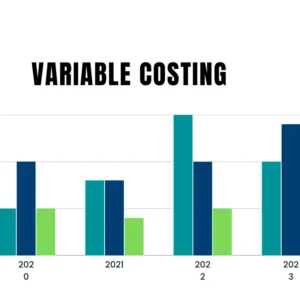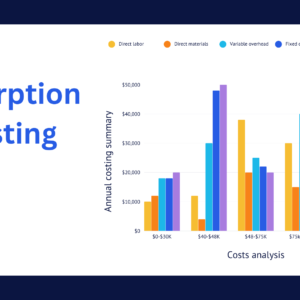- Introduction
- Common Techniques for Allocating Manufacturing Overhead Expenses
- Considerations for Choosing the Right Allocation Technique
- Benefits of Accurate Manufacturing Overhead Allocation
- Challenges and Limitations of Overhead Allocation Techniques
- Best Practices for Overhead Allocation
- Conclusion
Introduction
Definition of manufacturing overhead expenses
Manufacturing overhead expenses, also known as indirect costs, are the indirect expenses incurred in the production process that cannot be directly attributed to a specific product or service. Allocating Manufacturing Overhead is an important steps in managing manufacturing overheads. These costs are necessary for running the manufacturing operations but are not directly tied to the production of individual units.
Examples of manufacturing overhead expenses include rent, utilities, maintenance, depreciation of equipment, factory supervision, and quality control. It is crucial to accurately allocate and account for these expenses to determine the true cost of production, make informed pricing decisions, and evaluate the profitability of products or services.
Importance of allocating overhead expenses accurately
Accurately allocating overhead expenses is crucial for several reasons:
Cost Accuracy:
Accurate overhead allocation ensures that the true cost of producing goods or providing services is reflected, enabling more precise cost calculations and pricing decisions.
Profitability Analysis:
Proper allocation helps determine the profitability of individual products or services by attributing the correct overhead costs, allowing businesses to focus on profitable areas and identify areas that need improvement.
Resource Allocation:
Accurate overhead allocation helps in efficient resource allocation by identifying areas of high overhead costs, enabling businesses to allocate resources effectively and optimize production processes.
Decision-making:
Accurate overhead allocation provides reliable financial information for decision-making, such as investment decisions, cost reduction initiatives, and product diversification strategies.
Compliance and Reporting:
Proper allocation of overhead expenses ensures compliance with accounting standards and facilitates accurate financial reporting, enhancing transparency and credibility with stakeholders.
Common Techniques for Allocating Manufacturing Overhead Expenses
Traditional Overhead Allocation
Traditional overhead allocation is a commonly used method to assign indirect manufacturing costs to products or departments. It relies on predetermined allocation bases such as direct labor hours, direct labor costs, or machine hours to distribute overhead expenses. This method assumes that the allocation base is an accurate measure of the consumption of overhead resources.
However, traditional overhead allocation may lead to distortions and inaccurate cost assignments if the chosen allocation bases do not truly reflect the drivers of overhead costs. Despite its limitations, traditional allocation is still widely used due to its simplicity and familiarity. However, it is important to regularly review and reassess the validity and accuracy of the chosen allocation bases.
Activity-Based Costing (ABC)
Activity-Based Costing (ABC) is an alternative method for allocating overhead expenses that focuses on activities performed within an organization. ABC identifies the specific activities that consume resources and assigns costs based on the extent of their utilization. It recognizes that not all products or services consume overhead resources in the same way.
ABC involves identifying cost drivers, which are factors that influence the incurrence of costs, and then allocating expenses based on these drivers. By providing a more accurate and detailed understanding of cost behavior, ABC enables businesses to make informed decisions regarding pricing, product mix, process improvement, and resource allocation. It provides a more granular view of cost distribution compared to traditional overhead allocation methods.
Direct Cost Allocation
Direct cost allocation is a method of assigning overhead expenses directly to specific products or departments without using allocation bases. Instead of relying on predetermined factors like direct labor hours or machine hours, direct cost allocation assigns costs based on a cause-and-effect relationship.
This approach is useful when overhead expenses can be easily and directly traced to a particular product or department. By eliminating the need for allocation bases, direct cost allocation provides a more straightforward and simplified method of cost assignment. It can lead to more accurate cost calculations and facilitate a better understanding of the true costs associated with specific products or departments.
Considerations for Choosing the Right Allocation Technique
Complexity of manufacturing processes
When considering the complexity of manufacturing processes, it is essential to select an overhead allocation technique that can effectively capture and allocate costs. Complex manufacturing processes with multiple stages, departments, or product variations may require a more sophisticated approach like Activity-Based Costing (ABC).
ABC allows for a more accurate and detailed analysis of activities and their associated costs, ensuring a better understanding of cost drivers. However, for simpler manufacturing processes, traditional allocation methods like direct labor hours or machine hours may be sufficient and easier to implement. Matching the complexity of manufacturing processes with the appropriate allocation technique is crucial for achieving accurate cost allocation and decision-making.
Diversity of products or services
The diversity of products or services offered by a manufacturing business is another crucial consideration when selecting an allocation technique for overhead expenses. If the business produces a wide range of products or services with varying production processes and resource requirements, a more flexible and adaptable allocation method may be needed.
Activity-Based Costing (ABC) can accommodate this diversity by identifying specific activities and cost drivers associated with each product or service, allowing for more accurate cost allocation. In contrast, traditional allocation methods based on broad allocation bases may not capture the nuances of diverse products or services, leading to less accurate cost assignments. Therefore, the diversity of products or services should be carefully considered when choosing an allocation technique.
Availability and accuracy of data
The availability and accuracy of data play a crucial role in selecting the appropriate allocation technique for overhead expenses. Accurate and reliable data is essential for ensuring the precision of the allocation process. It is important to assess whether the necessary data, such as direct labor hours, direct labor costs, machine hours, or activity-based information, is readily available within the organization.
If the required data is not easily accessible or if there are concerns regarding its accuracy, it may be necessary to implement data collection and tracking systems or invest in data improvement initiatives before implementing more sophisticated allocation techniques. Adequate data availability and accuracy are fundamental in ensuring the effectiveness and validity of the chosen allocation technique.
Alignment with organizational goals and strategies
When selecting an allocation technique for overhead expenses, it is crucial to consider its alignment with the organization’s goals and strategies. Different allocation methods may have varying impacts on the financial results and decision-making processes. For example, if the organization’s goal is to improve cost efficiency and optimize resource allocation, Activity-Based Costing (ABC) may be a suitable choice due to its ability to identify cost drivers and allocate expenses based on activities.
However, if the organization’s focus is on simplicity and ease of implementation, traditional allocation methods may align better with its strategies. Choosing an allocation technique that aligns with organizational goals ensures that the chosen method supports the desired outcomes and facilitates decision-making processes accordingly.
Benefits of Accurate Manufacturing Overhead Allocation
Enhanced cost accuracy and pricing decisions
Accurate manufacturing overhead allocation offers several benefits, including enhanced cost accuracy and better pricing decisions. By properly allocating overhead expenses to products or services, businesses can obtain a more precise understanding of the true costs associated with each unit.
This accuracy allows for more informed pricing decisions, as it provides insights into the actual costs incurred in producing goods or delivering services. With accurate cost information, businesses can avoid underpricing or overpricing their offerings, ensuring profitability and competitiveness. Accurate cost allocation also helps in identifying areas of cost inefficiency and opportunities for cost reduction, enabling businesses to optimize their pricing strategies and improve overall profitability.
Improved product profitability analysis
Accurate manufacturing overhead allocation offers several benefits, including improved product profitability analysis. By allocating overhead expenses accurately, businesses can gain a clearer understanding of the true costs associated with producing each product. This allows for a more precise calculation of product profitability by taking into account all relevant costs, including indirect expenses.
With accurate profitability analysis, businesses can identify which products are generating the highest profit margins and focus their resources and efforts accordingly. It also enables better decision-making regarding pricing strategies, product mix optimization, and resource allocation, as businesses can identify and prioritize products that contribute the most to overall profitability. Ultimately, improved product profitability analysis leads to more informed strategic and operational decisions that can enhance the financial performance of the business.
Effective resource allocation and capacity planning
Accurate manufacturing overhead allocation provides several benefits, including effective resource allocation and capacity planning. By properly assigning overhead costs to products or departments, businesses can gain insights into the actual resources consumed by each area of the operation. This information allows for more informed decision-making regarding resource allocation, ensuring that resources are allocated efficiently to areas with the highest impact on profitability.
The accurate overhead allocation also enables better capacity planning, as businesses can understand the true costs associated with different levels of production. This helps in determining optimal production levels, identifying opportunities for expansion or contraction, and avoiding underutilization or overutilization of resources, leading to cost savings and improved operational efficiency.
Informed decision-making for process improvements
Accurate manufacturing overhead allocation provides several benefits, including informed decision-making for process improvements. By correctly assigning overhead costs to specific products or departments, businesses gain a deeper understanding of the true costs associated with different processes. This knowledge enables them to make informed decisions regarding process optimization and improvement.
With accurate cost data, organizations can identify areas of inefficiency, bottlenecks, or waste and implement targeted improvements to streamline operations, reduce costs, and enhance overall productivity. Informed decision-making for process improvements allows businesses to maximize their operational efficiency, improve quality, shorten lead times, and ultimately gain a competitive advantage in the marketplace.
Challenges and Limitations of Overhead Allocation Techniques
Difficulty in capturing and assigning all overhead costs
One of the challenges in overhead cost allocation is the difficulty in capturing and assigning all overhead costs. Not all costs incurred in the manufacturing process may be easily identifiable or directly traceable to specific products or departments. Some overhead costs, such as facility maintenance or administrative expenses, may be shared among multiple products or departments, making their allocation complex.
This challenge requires careful analysis and estimation to ensure that all relevant costs are captured and allocated accurately. Failure to capture and assign all overhead costs can lead to distorted cost calculations and hinder the accuracy of financial reporting and decision-making processes.
Subjectivity and reliance on assumptions
Subjectivity and reliance on assumptions are common limitations associated with overhead cost allocation. The allocation process often requires making subjective judgments and assumptions, such as selecting an appropriate allocation base or determining the extent of cost drivers. These subjective decisions can introduce bias and lead to inaccurate cost assignments.
Additionally, the accuracy of assumptions becomes crucial as they form the foundation of the allocation method. If the assumptions are incorrect or outdated, the resulting allocation may not reflect the true cost behavior. To mitigate these limitations, regular reviews, data analysis, and collaboration between finance and operations teams are necessary to ensure that assumptions are based on reliable information and aligned with the current business environment.
Potential for over/under allocation
One of the potential challenges in overhead cost allocation is the risk of over or under-allocation. Overallocation occurs when more overhead costs are assigned to a product or department than it incurs, leading to an overestimation of its cost and potentially affecting pricing decisions. Conversely, under-allocation happens when overhead costs are underestimated or not fully assigned, resulting in an understatement of the true cost and potentially impacting profitability analysis.
These discrepancies can occur due to inaccuracies in the allocation method or changes in the cost structure. Regular monitoring and adjustment of allocation methods are necessary to minimize the potential for over or under-allocation and ensure accurate cost assignments.
Time and resource requirements for implementation
Implementing an overhead cost allocation system can require significant time and resources. It involves collecting, analyzing, and categorizing data related to overhead expenses, as well as designing and implementing an appropriate allocation method. This process can be time-consuming and may require skilled personnel and advanced software tools.
Moreover, ongoing maintenance and updates to the allocation system may be necessary to keep it accurate and relevant. Organizations should allocate sufficient resources, including time, manpower, and technology, to ensure a smooth implementation and to address any challenges that may arise during the process.
Best Practices for Overhead Allocation
Regular review and reassessment of allocation methods
Regular review and reassessment of cost allocation methods are essential to ensure their ongoing effectiveness and accuracy. Business environments are dynamic, and factors influencing overhead costs can change over time. By conducting periodic reviews, organizations can identify any discrepancies, biases, or inefficiencies in their current allocation methods.
This allows for adjustments, refinements, or even the adoption of alternative methods that better align with the organization’s evolving needs. Regular reviews also provide an opportunity to incorporate feedback from stakeholders and improve the transparency and reliability of cost allocation processes. It is a proactive approach that ensures the continued relevance and validity of cost allocation methods.
Utilization of technology and automation
Utilizing technology and automation is a best practice for overhead allocation. Technology solutions and software can streamline the data collection and allocation process, reducing manual errors and improving efficiency. Automation can help in capturing and processing large volumes of data, performing complex calculations, and generating accurate allocation results.
It also enables real-time monitoring and reporting of overhead costs, providing timely insights for decision-making. By embracing technology and automation, organizations can enhance the accuracy, speed, and reliability of their overhead allocation processes, freeing up resources for more strategic activities and improving overall cost management.
Collaboration between finance and operations teams
One of the best practices for overhead allocation is fostering collaboration between finance and operations teams. Both teams possess valuable insights and expertise that can contribute to the accuracy and effectiveness of cost-allocation processes. Collaboration ensures that the finance team has a deep understanding of the operational aspects impacting overhead costs, while the operations team gains visibility into the financial implications of their decisions.
By working together, they can align cost allocation methods with operational realities, validate data accuracy, identify areas for improvement, and jointly develop more accurate and efficient allocation models. This collaboration enhances the accuracy of cost assignments, strengthens decision-making, and promotes a holistic approach to cost management.
Periodic benchmarking and comparison with industry standards
Periodic benchmarking and comparison with industry standards are considered best practices for overhead allocation. Benchmarking involves comparing an organization’s overhead allocation practices with industry peers or recognized standards to assess performance and identify areas for improvement. By benchmarking, businesses can gain insights into industry norms, best practices, and emerging trends.
It allows them to evaluate the effectiveness and efficiency of their allocation methods and identify opportunities for optimization. Benchmarking helps organizations stay competitive, drive continuous improvement, and ensure that their overhead allocation practices are aligned with industry standards, leading to more accurate cost calculations and better decision-making.
Conclusion
Allocating manufacturing overhead expenses accurately is crucial for businesses to make informed decisions, improve cost management, and enhance profitability. Traditional methods like direct labor hours or direct labor costs can be simple to implement, but they may not accurately reflect the drivers of overhead costs. Activity-Based Costing (ABC) provides a more detailed and precise approach by identifying cost drivers and allocating expenses based on activities.
Direct cost allocation assigns costs directly to products or departments without relying on allocation bases. Choosing the right allocation technique requires considering the complexity of manufacturing processes, alignment with organizational goals, and the availability of data. By adopting suitable allocation techniques, businesses can gain a better understanding of their costs, optimize resource allocation, and drive informed decision-making.




